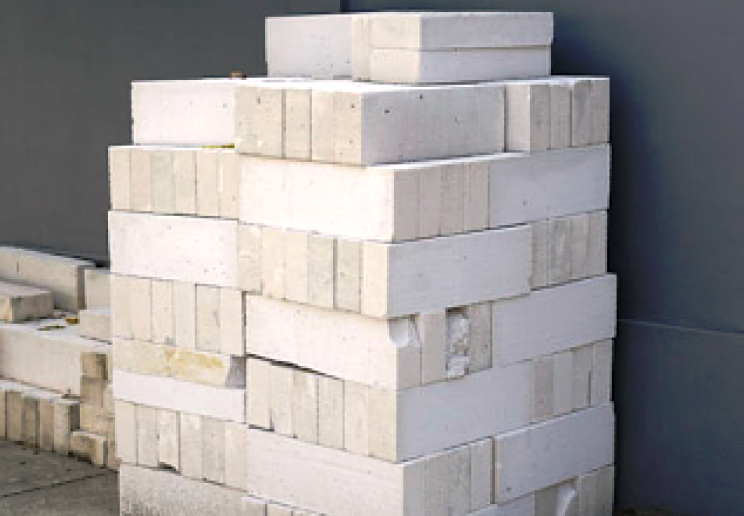Benefits of Concrete Blocks in Construction

Prominent construction industry organizations have begun offering substantial trainings on the benefits of concrete blocks to businesses and staff. Encouraging more concrete buildings that are low-emission and environmentally conscious is the driving force behind these developments.
Different materials can be used to produce concrete blocks in a variety of sizes and shapes. Concrete blocks offer the benefits of allowing for the construction of long-lasting, sturdy structures. But in order to reach this level of efficiency, a few factors are crucial, like selecting a supplier, using the product’s raw materials in the right amounts, and the experience and skill of the workers during the construction stage.
Concrete blocks: What are their benefits?
Under the following headings, the advantages of concrete blocks can be broadly categorized:
- They withstand calamities like floods and fires.
- Numerous designs are possible for its external surfaces.
- Mass and muffle are two ways they improve acoustic performance.
- It offers excellent thermal protection. In the summer and the winter, they stay toasty.
- They are inexpensive to maintain even though they are good for extended use.
Insulation against heat.
Due to proper materials being used to fill in gaps, concrete blocks have a high thermal insulation value. In order to optimize the benefits of thermal insulation, studies have recently begun. U-value, a system designed for these studies, is used to determine the right combinations of blocks and insulation. Heat transfer rate between materials is measured using the U-value.
Certain warehouses can now have the minimum air permeability needed because of these studies on the improved performance of concrete blocks.
Look Diverse
The traditional gray tone and sleek appearance of the concrete block are typically what come to mind. Actually, one can choose how to handle this. Because they can have their exteriors painted with different surface coatings and patterns to create an attractive design.
For prospective clients, a workplace’s architectural design and aesthetic elements may be significant. It’s also possible that they want the advantages of a concrete home along with a lovely appearance. As such, the options for businesses and housing are numerous.
Acoustic Performance
The advanced sound insulation on walls and floors is a result of the natural mass and damping properties of concrete block. Having sound insulation doesn’t require any extra expenses.
The isolation of noise between apartments is a significant concern, particularly for residents of apartment buildings. The environmental and construction noise regulation has established its standards. When starting construction and choosing materials, this is something that needs to be considered. A home built with concrete blocks can have the best possible sound insulation.
Possibility of Flexible Design
Outside of exterior surface applications, concrete blocks can have a wide variety of designs. Their production in various sizes and dimensions is impressive when viewed from a structural perspective.
Types, Applications, Pros, and Cons of Concrete Blocks
An imposing, long-lasting construction is created by mortaring together concrete blocks, which are referred to as “Building Blocks” in this sense. These construction blocks can be ‘Hollow’ or ‘Solid,’ formed of ordinary or lightweight concrete in various specified sizes, depending on the precise requirements. Both solid and hollow concrete blocks are available in a variety of sizes and shapes. 39cm x 19cm x (30cm or 20 cm or 10cm) or 2 inch, 4 inch, 6 inch, 8 inch, 10 inch, and 12-inch unit configurations are the most popular concrete block sizes. Cement, aggregate, and water are used to make concrete blocks. Cement to aggregate in concrete blocks is 1:6.
Concrete Block Types: Two types of concrete blocks are available:
- Blocks of solid concrete
- Blocks of hollow concrete
1. Blocks of solid concrete:
Mostly used in construction projects, solid concrete blocks are extremely heavyweight and composed of aggregate. They add a lot of solidity and durability to buildings. For massive constructions like force-bearing walls, these solid blocks are perfect. Big bricks are the analogy used to describe them. Since brick masonry requires more time to construct, concrete masonry requires less time.
2. Blocks of hollow concrete:
Concrete blocks with hollow interiors are commonly used in masonry construction. Along with expediting construction and conserving steel and cement, it lowers labor costs on the job site. By improving the physical characteristics of walls, such as insulation from noise and heat, these blocks also lessen the inherent weight of masonry constructions. Both full size and half size are available for standard hollow concrete blocks. Whereas full-sized blocks are rectangular and have two cores, half-sized blocks are cubical and have one. As stated by the “Research Designs & Standards Organization of Indian Railways,” concrete blocks have the following nominal size:
A measurement of either 200 or 100 mm in height or 400, 500, or 600 mm in length iii) A breadth of 50, 75, 100, 150, 200, 250, or 300 mm.
The shapes, sizes, and designs of hollow concrete blocks vary based on the shape, requirements, and design.
1. Stretcher blocks made of concrete:
Also used at the corners of the masonry are concrete stretcher blocks. Blocks of hollow concrete are frequently used for concrete stretcher construction. Concrete stretcher block parallel lengths are positioned parallel to the facial plane.
2. Corner Blocks Made of Concrete:
Corners of the masonry and the ends of windows and doors are filled with concrete corner blocks. A stretcher design adorns one block corner, while the other is plain. The plane’s exposed end is fastened to the outside using stretcher blocks by positioning concrete corner blocks in that position.
3. Lintel Blocks:
Forming lintel beams requires joining lintel blocks together. These beams distribute loads from above the beam to the walls on both entry sides, thereby providing structural support. In addition, they are constructed of pre-stressed concrete and are prefabricated.
4. Blocks of concrete pillars:
Concrete pillar blocks, also referred to as double corner blocks, have plain corners on both ends. They are therefore frequently used when two corners are visible. Concrete pillar blocks, as the name suggests, are frequently utilized for piers and pillars.
5. Concrete Blocks for Partitions:
The height of a partition concrete block, also called a partition block, is greater than the breadth. These blocks resemble concrete pillar blocks. Two or three sections make up the hollow section of a partition block. For constructing partition walls, these blocks are ideal.
6. Concrete blocks with jambs:
Jamb blocks are used when there’s a complex window aperture in the wall. They are fastened with corner blocks and stretchers. If you are installing double-hung windows, you will need jamb blocks to make room for the window casing components.
7. Concrete Block with Bullnose Shape:
Bullnose concrete blocks are the same as concrete pillar blocks. A bullnose block has rounded corners, whereas a concrete pillar block does not; this is the primary difference between the two kinds of concrete blocks. If you’d like rounded edges, bullnose concrete blocks might be the best option.
8. Bricks that are fogged:
A header, stretcher, and frog section are present on the top surface of this type of block. By strengthening the bond between bricks, frog helps mortar stay in place.
9. Interlocking Blocks:
Recycled concrete boxes, either square or rectangular, are used as paving blocks. In order to create a beautiful pavement, decorative concrete blocks called pavers are utilized. While they can be used to construct walkways and parking lots, paving blocks are most frequently used in the construction of roads. When used for road shoulders and paving, paving blocks must be painted with high-visibility paints so that vehicles can see them.
10. Blocks of Lightly Aerated Concrete:
One characteristic of light-aerated concrete blocks is their light weight. Portland cement, fine sand, aggregates, and other ingredients go into making these blocks. Consequently, they are made using aerated concrete.
11. Eleventh, Fly Ash Blocks:
Bricks made of fly ash are less expensive and lighter than clay bricks. The waste products from burning coal in thermal power plants are typically used to make them.
12. Concrete Blocks with Cellular Structure:
It is the lightweight nature that distinguishes cellular lightweight concrete blocks. Along with their low heat conductivity, these blocks have a high mechanical strength. Concrete blocks with cell structure are made of low-density Portland cement containing tiny air bubbles.
13. Bricks made of concrete:
Rigid walls are made with concrete bricks, which are tiny, symmetrical, rectangular blocks. The compressive strength of these bricks is higher than that of regular clay bricks, and they also absorb less water. Most commonly, fly ash, sand, and cement are used to make concrete bricks. The beautiful and modern aesthetic look of these blocks makes them ideal for use in facade fences.
Concrete Block Applications:
- Due to their rapid and simple installation, concrete blocks are an excellent choice for partition walls. Strengthening the structure is achieved by adding steel reinforcement.
- Exterior and Interior Load-bearing Walls, Partition Walls, Panel Walls, and Boundary Walls are common uses for Hollow Concrete Blocks.
- Though they also function well for non-load bearing walls and garden walls, solid concrete blocks are ideal for building chimneys and fireplaces.
- A range of smaller landscaping projects also make use of concrete block construction. Decorative screens, outdoor seating, outdoor bars, flower beds, and many more are a few examples of outdoor furniture and patio ideas.
- The effects of fluctuating weather can be mitigated by covering commodities in concrete blocks. Engineers prefer it for building Material Bins, which is not surprising.
Concrete blocks’ benefits include:
- By using more carpet area, the space appears larger due to the lower wall thickness caused by the narrower Concrete Blocks used than in a typical brick masonry wall.
- Thanks to the large size of the blocks, concrete block building is more organized, quicker, and more durable than brick masonry.
- Improved thermal protection is offered.
- The interiors are shielded from noise pollution and sound is effectively absorbed. There is extra fire protection when using concrete blocks.
- Conserves valuable agricultural land that is heavily mined for clay brick production.
- Enabling a rapid building cycle turnaround is possible by manufacturing individual pieces to a larger customized size and shape.
- Because of their uniform size, which reduces the need for plaster, concrete blocks are a more affordable option than traditional bricks. While the overall strength of the structure is increased, the mortar consumption rate is lower than in traditional masonry construction.
Concrete block drawbacks include:
- Building a house from concrete blocks is much more expensive.
- For the purpose of accessing vital systems, some of the blocks might need to be cut.
- Generally speaking, the exterior of concrete block homes is not appealing.
- Seepage of water may occur in concrete blocks over time.
- This material might not be appropriate for certain regional tastes.
- The environmental benefits can be readily offset by windows and doors.
In conclusion, concrete block houses are a sensible choice for those who wish to live sustainably. In contrast to timber frames, most homeowners can recover the cost difference over the course of the property’s lifetime, even though the cost of building is higher with this material.

